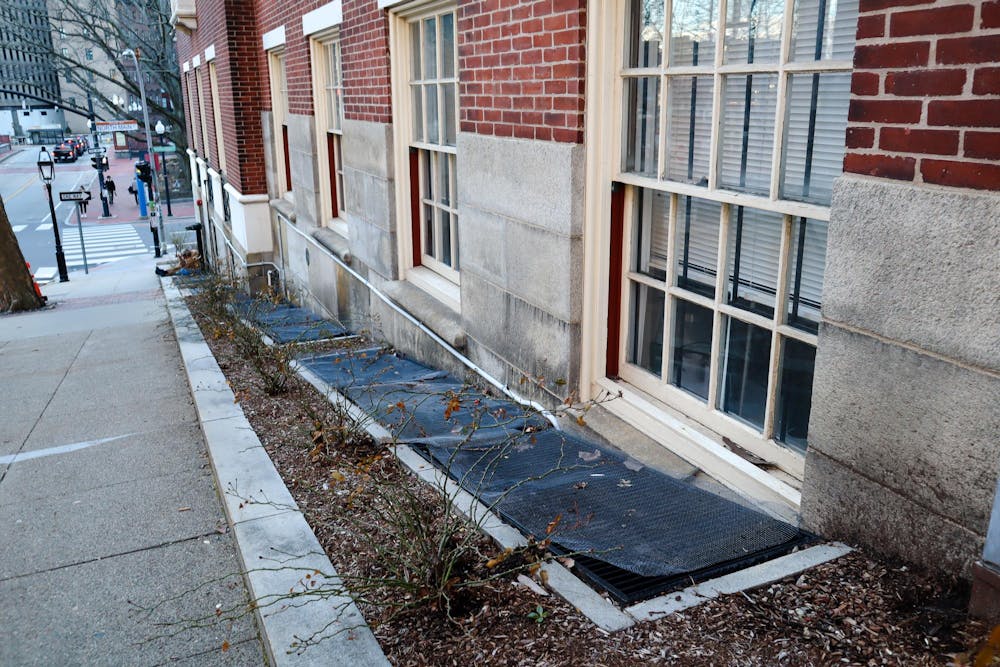Two weeks ago, Rhode Island School of Design staff installed a metal structure over an air vent next to 2 College St., a site where an unhoused woman usually sleeps. On Feb. 22, Waverly Huang, a RISD sophomore, started a petition to have the grate removed, which amassed over 1,000 signatures. A day later, the grate was removed.
“It just appeared one day, and then we were like … ‘what the heck, why is this here?’” Huang said in an interview with The Herald. Huang, who is secretary of RISD’s student alliance, felt obligated to act against what, in her view, was a design choice targeting unhoused individuals.
The unhoused woman, who spoke to The Herald on the condition of anonymity citing safety concerns, said she has been sleeping by 2 College St. for seven months now. According to her, a few other individuals sleep across the street. “We stayed in this spot because it was alright to be seated here,” she said, adding that the heat from the vent and the wall made the spot a warm place during the night.
After a few days of relocating farther up College Street, she is back sitting and resting by the vent, following the removal of the grate.
For Huang, questions remain about why the grate was installed in the first place. “If someone wants to sit near … (a) building where there is a vent that keeps them warm, there is not a problem with doing that–especially if they are not malicious,” she said. The petition’s commenters also described the structure as an example of hostile and anti-homeless architecture.
Hostile architecture is an urban design tactic that repurposes existing public structures to prohibit certain groups from using such spaces and performing certain activities including sleeping, according to The Neighborhood Design Center.
“While public space is intended to broadly serve the public good … hostile architecture can then be used to restrict the use of a public space based on race, age, income, and other factors deemed undesirable,” reads the NDC website.
According to Brenda Clement, director of HousingWorks RI at Roger Williams University, hostile architecture uniquely affects unhoused individuals, since they are more dependent on public spaces for shelter.
“Part of the reason why (unhoused individuals) are hanging out in public spaces is that they don't have housing, or good alternatives that provide a safe environment,” said Clement. She also noted that shelters still make people “leave early in the morning.”
“People have to find ways to occupy their days, and sometimes that is in public spaces,” she added. “We have to address the housing problem, and the homelessness problem, so that hanging out in a public space, park or down at Kennedy Plaza is not the only option for” people experiencing homelessness.
According to Huang, RISD students did not receive any direct communication about the grate installation or removal.
RISD Senior Director of Public Relations Jamie Marland confirmed it was RISD staff who installed and removed the grate. “We appreciate the concerns that were raised and acknowledge the importance of addressing this matter in a manner that respects the wellbeing and dignity of all individuals involved,” Marland wrote in an email to The Herald.
Marland wrote that “the decision to install the grate was made due to serious health and safety risks to the community, given the ways in which the well and surrounding area were being used.” The unhoused woman who rests in that area stated that she believed RISD installed the grate to protect individuals, including her, from a nearby generator. RISD did not specifically comment on what health and safety concerns they hoped to address by putting up the grate.
The woman stated that she was informed before the grate was installed, and told she could come back “in a few days.” RISD did not respond to a specific request for confirmation about whether or not the institution informed unhoused individuals in the area about the grate installation.
The unhoused woman said that RISD has been “wonderful” to her. “They never were a problem ever,” she said.
Last year, HousingWorks RI released their 2023 Housing Fact Book, which stated that the number of people experiencing homelessness in Rhode Island has risen by 72% since 2019, The Herald previously reported.
Included in the study, as a part of its 2023 Point-In-Time Count, was “a count of sheltered and unsheltered people experiencing homelessness on a single night in January.” The Rhode Island Coalition to End Homelessness found from the count that 1,810 people were without housing at that time.
From her experience, the woman who stays near RISD said that housing organizations in Rhode Island have been “very nice about explaining where we can go with inclement weather.” However, having been “kicked out” from her residence during the pandemic she, like many other Rhode Island residents, lacks a permanent home.

Sanai Rashid lives in Long Island, New York. As an English and Economics concentrator, she is passionate about storytelling and how numbers and data create narratives in ways words alone cannot. When she is not writing, you can find her trying new pizza places in Providence or buying another whale stuffed animal.

Ciara Meyer is a section editor from Saratoga Springs, New York. She plans on concentrating in Statistics and English Nonfiction. In her free time, she loves scrapbooking and building lego flowers.





